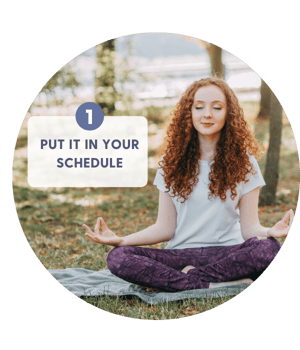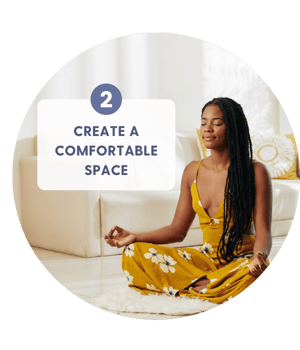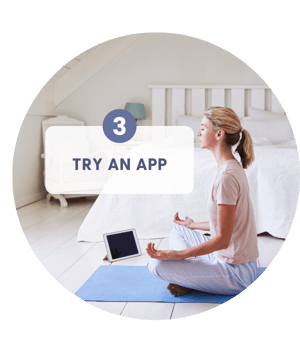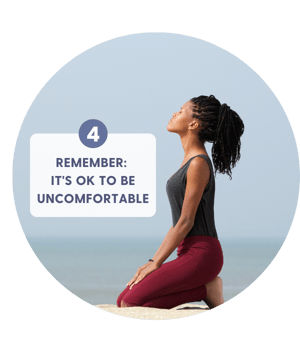Our world is so hectic that people are constantly seeking out ways to manage and reduce stress. That may explain why meditation has become a popular stress relief option in recent years. Meditation is a free and easy way to receive proven mental and physical health benefits. Curious about giving it a try?
Table of Contents
What Exactly is Meditation?
Meditation is a practice that includes developing focus and entering into a different state of awareness. It is the practice of entering a relaxed state and observing your thoughts, breath, and body. There are many benefits to developing a meditation practice.
The Benefits of Meditation
Meditation has many scientifically proven benefits for both your mental and physical health. It can help you to be more at ease and enjoy greater peace.
In terms of mental health, meditation helps you:
- Reduce stress
- Reduce negative emotions
- Increase creativity
- Increase patience
- Be more present at the moment
- Increase self-awareness
- Increase self-understanding
- Connect with others
- Understand your emotions better
- Gain coping skills for stress
- Focus more
- Sleep better
- Have more empathy
- Reduce anxiety and depression
Developing a regular meditation practice may help you to better manage symptoms of the following conditions:
- Insomnia
- Asthma
- Cancer
- Heart disease
- High blood pressure
- Irritable bowel syndrome
- Headaches
It is further proven to lower your rate of respiration and heart rate and even to change your brain wave patterns.
Types of Meditation

There are many different types of meditation. Some require stillness, and others require movement.
1. Guided Meditation
Guided meditation occurs when you listen to someone speaking in person or via a recording. They often tell you to notice your five senses, how you are feeling physically, and your thoughts.
Guided meditation may include a relaxing scene or a suggested visualization.
2. Mindfulness Meditation
This can be done with or without a guide or teacher. In this practice, you observe your thoughts as they come up. You don't judge them; you simply see them and allow them to pass by. Some people focus on their breath in order to help with the practice.
3. Mantra Meditation
Repeat a word or phrase out loud or in your head. The phrase helps you to remain focused on an intention and also helps to prevent distractions.
4. Visualization Meditation
Visualize something special to you, like a white light beaming down on you. You can also visualize a relaxing setting or a scene of something you would like to manifest in your life.
5. Spiritual Meditation
When a meditation practice is paired with a spiritual or religious practice, it is known as a spiritual meditation.
6. Focused Meditation
Focus on one of your five senses to help focus your mind and restrict distracting thoughts. You might stare at a burning candle, count beads, or listen to a gong or specific song.
7. Moving Meditation
Qi gong, tai chi, and yoga are all forms of moving meditation. Even walking or gardening can be forms of meditation. For some people, moving while practicing mindful meditation can solidify a connection to the body and create more bodily awareness.
8. Transcendental Meditation
When practicing TM, you assign yourself a personal mantra and spend your meditation time repeating that phrase to yourself. This form of meditation is, for many people, a more accessible starting point than other forms of meditation.
9. Body Scan Meditation
During this type of meditation, you focus on each part of your body and pay attention to how it feels, then try to relax that part of the body. Focusing on your body can help to keep you mentally present.
How to Start Your Meditation Practice
Start by meditating for just 5 or ten minutes a day. Once you are more comfortable with meditation, increase the amount of time you spend meditating.
It's best to start with a basic and accessible practice, like this one:
Step 1: Turn off your distractions. Put your phone on silent, turn off the podcast you're listening to, and shut the TV off. You may choose to listen to quiet repetitive music, a mantra, or an audio recording of guided meditation.
Step 2: Set a timer so you don't have to worry about how much time has passed. Make the alarm a relaxing tone.
Step 3: Get in a comfortable position. You can sit in your favorite chair or lie down. Just make sure that you will be able to maintain your chosen position for the length of the meditation.
Step 4: Focus on your breathing. Take deep breaths. Notice how the air is cooler when you inhale and deeper when you exhale. Notice how it feels to take full deep breaths and how it feels to release them.
Step 5: Notice your thoughts and let them go. If it helps, you can think of each thought as a balloon that simply floats past you. When you notice your mind wandering, bring your attention back to your breath.
Tips for Meditating
Meditation can seem overwhelming to start. If you're having trouble starting for the first time, try some of these meditation tips!

Mark on your calendar when you would like to meditate. Set a notification so you will be more likely to do it.

Create a special space where you meditate, even if everything else in your living space is chaotic. It might just be a particular pillow that you sit on or a corner of the room that is exclusively yours.

There are several meditation apps out there that can help you by sending you reminders, suggesting breathing exercises, offering guided meditations and visualizations, and providing gentle timers for your meditation practice.

If you are uncomfortable in your mind or body, notice that during your meditation. It's common for difficult emotions to come up during meditation. Instead of resisting them or judging them, just observe them. Becoming comfortable with discomfort is one of many lessons you can learn from meditation.

You and a friend can keep each other accountable by being meditation buddies. Tell each other your meditation plan and let each other know if you stick to it or not.
Ready to Grow?
Meditation is a wonderful option for a healing or growing journey. People who practice meditation can benefit from studying with a teacher or from working with people who practice other healing arts. If you're looking for other practitioners to help you along the way, finding someone online is a great place to start.
Learn more about meditation
|
|
|


.webp)





